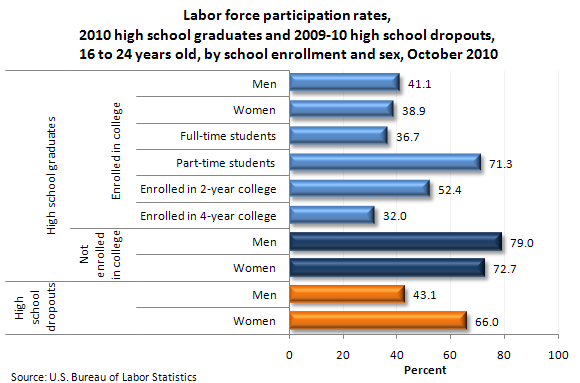Labor Force Participation Rates
Recently, several college students have been complaining that they lost their jobs. It’s certainly not easy to pull an all-nighter to finish a research paper and then be polite to customers at 8:oo a.m. Recent numbers show that college students are working much less than high school graduates who are not enrolled in college. While this statistic may mostly reflect the fact that in the United States, many students do not choose to be part of the labor force while they are in school, the percentage of non-working college students may also reflect some of the difficulties that students have retaining work while they have academic duties.
In October 2010, recent high school graduates not enrolled in college were more likely than enrolled graduates to be working or looking for work (76.6 percent compared with 40.0 percent). Recent high school graduates enrolled as full-time students in October 2010 were about half as likely to be in the labor force (36.7 percent) as those enrolled as part-time students (71.3 percent).
In October 2010, the labor force participation rates (the proportion of the population working or looking for work) for male and female high school graduates enrolled in college were about the same (41.1 and 38.9 percent, respectively). Recent high school graduates enrolled as full-time students in October 2010 were about half as likely to be in the labor force (36.7 percent) as those enrolled as part-time students (71.3 percent).
Among recent high school graduates who were enrolled in 4-year colleges in October 2010, 32.0 percent participated in the labor force, compared with 52.4 percent of recent graduates enrolled in 2-year colleges.
In October 2010, the labor force participation rate for recent high school dropouts (53.9 percent) was lower than for recent high school graduates not enrolled in college (76.6 percent).


